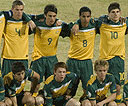 As I prepare to return home following my time covering the Joeys at the 2011 Under-17 World Cup in Mexico, two moments stick out at me. One of them occurred on Wednesday afternoon in the 89th minute of Australia’s disastrous 4-0 loss to Uzbekistan.
As I prepare to return home following my time covering the Joeys at the 2011 Under-17 World Cup in Mexico, two moments stick out at me. One of them occurred on Wednesday afternoon in the 89th minute of Australia’s disastrous 4-0 loss to Uzbekistan.
I was standing just meters away on the touchline as Davlatbek Yarbekov wheeled away in delight after putting the final nail in the Joeys’ coffin with his side’s fourth goal.
At the same time, midfielder Jacob Melling and goalkeeper Paul Izzo stood toe-to-toe screaming at one another.
Down to nine men, battered by a string of bad luck off the pitch, and now on their way out of the tournament, it all became too much for these young footballers. From the touchline, you could feel the chaos and turmoil envelop them.
15 minutes later, Melling walked out of the Joeys change room with a distraught face that framed sore-red eyes. As he walked through the mixed zone, Football Federation Australia’s technical director Han Berger pulled the young midfielder aside, put his arm around Melling’s shoulder, then simply stood there and rode the moment out with him.
It was a gesture of compassion that reminded me that, while these were talented footballers representing their country on the global stage, they were also still young boys: teenagers who were in Mexico to learn, even if from their mistakes.
After all, that’s what a developmental tournament like the Under-17 World Cup is all about.
So don’t consider the 4-0 loss to Uzbekistan as a backward step but a moment where obstacles like a weather suspended game, a delayed flight, a solitary day off between games, and dry oppressive heat that sucked the moisture out of your skin overwhelmed a group of 15, 16 and 17-year-olds.
In the end, what really matters are the performances across all four games, where the nuances and variables of individual matches don’t blur the reality.
And in that regard, the Joeys struggled.
Even at their best – the opening 30 minutes against both Brazil and Uzbekistan – Australia lacked fluency in attack and a mobile midfield to play through. Furthermore, at no point during the tournament were the Joeys able to play out from the back when being pressed high up the pitch.
Herein lies some key questions for Australian football, with significance not just for the developmental teams, but right up through the game’s pyramid.
The first and most obvious one is the ability of head coach Jan Versleijen to prepare and educate his players to the highest possible level. I have no doubt the Dutchman understands the system he is charged with teaching.
After all, he’s a product of it himself.
But the question being asked is if he has the unique qualities to be able to show others how to play in such a way at the highest level.
Versleijen’s contract will expire soon after the Young Socceroos’ own World Cup campaign later this month, and when that happens, his performances will be scrutinised and considered.
It is, of course, difficult to measure his success at this stage as his role is to develop Australia’s premier identified young footballers so they can progress through the system – an outcome that is not understood through the results of a solitary tournament.
However, with FFA paying top money for the position, they have a right to expect the best.
Yet the examination shouldn’t end with Versleijen, but must run right through the system that this playing group has come through. Top of that list should be the quality of the National Youth League.
It is clear to me that simply teaching AIS students how to play the 4-3-3 system against NYL standard opponents isn’t enough.
The diversity in playing characteristics, and standard of football at this World Cup, was simply too high for the AIS based Joeys to adapt to.
So how do you make the NYL stronger and more consistent, and if that’s not possible, how can FFA work around this?
Finally we come to the role of the AIS in Australia’s brave new dawn of technical and tactical football.
It doesn’t surprise me that, after a group of players drawn almost exclusively from the AIS struggled so significantly at the World Cup, the institute’s future role is being pondered.
Yet it remains an institution of fundamental importance to Australian football as it is a place where young boys and girls of all financial and social backgrounds have the opportunity to learn their craft.
If the 2011 Under-17 World Cup post mortem finds that the AIS is failing its students, it won’t be because the institute is no longer relevant, but because the system itself needs more work.
However before we run off on this crusade there’s one last thing I’d like to be remembered.
The other moment I mentioned earlier that will stick with me for many years to come happened on the day before Australia’s group game against Brazil during a joint pre-match press conference between both teams.
After I’d asked Versleijen how he responded to the criticism he’d received back home following the Joeys’ uninspiring win against Ivory Coast, the Brazil coach Emerson Avila chimed in. (http://theworldgame.sbs.com.au/FIFA-U-17-World-Cup/news/1061933/Versleijen-defends-Joeys-style)
“I feel that the criticism is not merited because Australia played really well,” Avila explained before going on to complement the “intelligent” and “interesting way, possessing the ball” Australia had shown against Ivory Coast.
This was the first time I’d sat through a press conference involving an Australian football team where the opposition coach had lauded skills other than mental and physical strength.
If nothing else, we can be proud of this first step we’ve taken as a football nation.





























































































